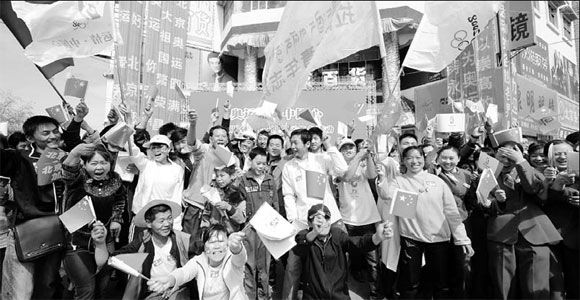

The Dalai Lama is under fire in the media after a video was shared of his inappropriate interaction with a child. Many people around the world were shocked to see this disturbing behavior, coming from someone who is often touted by Western media as a “holy man” or even a “social justice leader.”


Youths in Lhasa, Tibet, China, opposed to Dalai Lama, demonstrate to support the 2008 Olympics being held in Beijing, May 4, 2008. (Photo: China Daily)
But this morally questionable behavior comes as no shock to anyone familiar with the Dalai Lama’s corrupt and deceptive history — including his having enslaved thousands of people before the revolutionary overthrow of feudalism by the Tibetan people and his subsequent years as an operative for U.S.-backed regime change, while on the CIA payroll.
Tibet has been politically merged with other parts of China — now the People’s Republic of China — for hundreds of years in some form or another, having been officially incorporated with China since at least the 1720s under the Qing dynasty. There was a brief period after the fall of the Qing dynasty, when Tibet was recognized internationally as a part of the Republic of China, but local rule was mostly exercised by feudal lords and monastic leadership.
Tibet, at this point, was a society still under a brutal feudal system, at which the Dalai Lama stood at the helm. Enslaved people and serfs were freely bought and sold, traded like commodities by the ruling class. Torture and forced marriages were common. Before 1959, the clan of the 14th Dalai Lama owned 27 manors, 30 pastures and around 6,000 slaves and serfs.
Tibet after 1949 Revolution
Victory of the Communist forces in the 1949 Chinese Revolution ousted the reactionary forces of the mainland, but the Communist Party of China proceeded gently as far as the administration of Tibet was concerned, incorporating it into the People’s Republic as an autonomous region.
The Communist leadership understood that the overthrow of feudal society is a hugely progressive development, but this process could not be forced from the top down. Over the next decade, much of Tibet’s social practices remained in place, while mass support for the social revolution grew. The Communists built roads, hospitals, schools and other amenities, while leaving intact local feudal governments and the Buddhist religious structure for most of the 1950s.
At the same time, the CIA had begun to plant the seeds of counterrevolution, recruiting and arming contra-style death squads, coordinated by the Dalai Lama’s brother and inner circle based in India.
The U.S.-backed Tibetan mercenaries were brought to Camp Hale in Colorado, where they were trained, and subsequently dispatched on air-drop missions throughout Tibet to carry out attacks against People’s Liberation Army troops, assassinations and other terrorist maneuvers. These operations were meant to give the illusion of a popular movement against the Communist Party; and they came to a head in 1959, when the Dalai Lama and the CIA launched an “uprising,” which was painted by Western media as a “liberation movement.”
The attack on China ended with the overturning of the Dalai Lama’s regime and his exile to India — and an end to serfdom in Tibet.
To this day, the Dalai Lama heads a “government in exile,” the Central Tibetan Administration based in India, which was established by the CIA and has been upheld with money from the National Endowment for Democracy and the U.S. State Department.
Despite this history, the Dalai Lama is still hailed by Western media as a peace-loving man, while the CTA continues to spread misinformation about People’s China’s alleged occupation and cultural genocide of Tibet, employing the same formula applied by the CIA/NED-backed groups in other regions like Xinjiang and Taiwan.
With U.S. imperialism pounding relentlessly on China’s door, it’s clear that the best prospects for a free and autonomous Tibet are through maintaining its status, as an autonomous region within the multinational state of the People’s Republic of China, rather than surrendering itself to becoming a neocolony of U.S. imperialism and a staging ground for the U.S. war drive against China.
The U.S. approach to Tibet is in some ways comparable to its approach toward the former Soviet Union and Ukraine.
For those who didn’t see it previously, it can now be seen with crystal-clear hindsight that U.S. attempts to foster reactionary Ukrainian nationalism, in order to Balkanize the former Soviet Union, have landed Ukraine in a worse situation. Ukraine is sovereign in name only and is economically dependent on the U.S.; the country functions as a proxy of the U.S. empire, sentenced to be the human shield for the U.S. and NATO in a major military conflict against Russia.
With a potential U.S. war with China drawing nearer by the day, Tibetans have no reason to believe their situation would end any differently if U.S. imperialist notions of “independence” hold sway.
Raposo is a Portuguese Marxist analyst, editor of the web magazine jornalmudardevida.net, where this article…
By Alireza Salehi The following commentary first appeared on the Iranian-based Press TV at tinyurl.com/53hdhskk.…
This is Part Two of a series based on a talk given at a national…
Educators for Palestine released the following news release on July 19, 2025. Washington, D.C. Educators…
On July 17, a court in France ordered the release of Georges Abdallah, a Lebanese…
The following are highlights from a speech given by Yemen’s Ansarallah Commander Sayyed Abdul-Malik Badr…